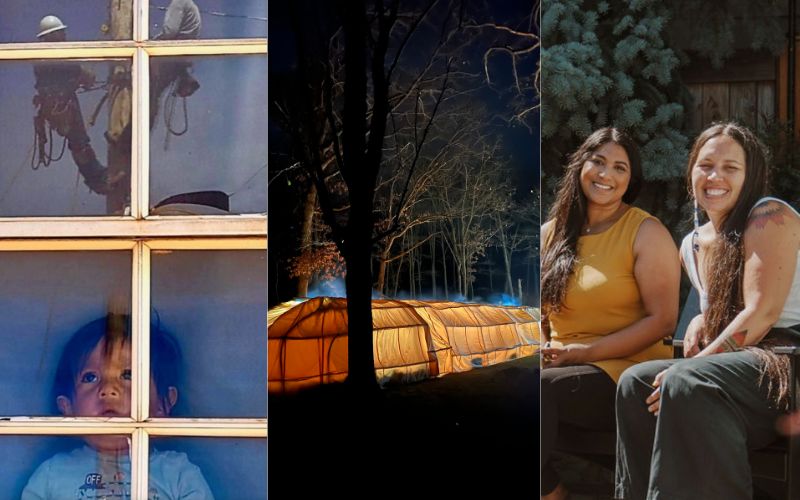
- Details
- By Native News Online Staff
Year in Review - 2023. During the course of 2023, Native News Online published more than 1,000 articles. Some of the articles were written and posted quickly to keep up with current events happening in Indian Country. Others took longer to research, to coordinate interviews with sources that add to the stories and some required travel.
We asked our senior editor and writers to select their favorite article of 2023 that they filed:
Elyse Wild | Senior Editor
Of all the stories I wrote this year, the one I feel most deeply connected to is Lighting Up Navajo Nation, which tells the story of a mutual aid project that brings volunteer linemen from around the country to hook up homes in the Navajo Nation to electricity. Learning that there are more than 13,000 Dine families living without the basic necessity of electricity — and even more living without running water — drove me to dive deeper.
I met Dine families, young and old, who were getting electricity for the very first time and learned what their day-to-day lives were like without it. I learned about how a law passed in 1936 excluded Tribal Nations from the “electrification” of homes in the United States, and how federal bureaucracy and apathy continue to leave thousands of Native families living without basic utilities. I was deeply moved and inspired by a partnership between the Navajo Utility Authority and the volunteer utility, achieving what the federal government has failed to do for generations.
 Make A Donation Here
Make A Donation Here
Jenna Kunze | Senior Reporter
My favorite story I wrote this year was the doula story.
When I first heard the statistic, I knew I had to write a story about it: Native mothers in Washington state die 8.5 times more often than white mothers in and around childbirth, owing to system failures and unconscious biases in the Evergreen State's health system. For this story I highlighted the Indigenous doulas that are changing that statistic—they’re literally saving lives– by nurturing mothers and newborns in a culturally appropriate way.
Kaili Berg (Aleut) | Reporter
One of my favorite stories I have covered this year includes the ongoing effort of the Ho-Chunk Nation to preserve the Hooçak language. Being based in Wisconsin and growing up in the Ho-Chunk community, these efforts mean a lot to me. Bringing language within a cultural context is important, especially the traditions within it. Seeing the ways the Ho-Chunk brought language and culture together made me understand those connections on a much deeper level. Looking forward to 2024, I am excited to shed more light on issues such as language revitalization, as there is more work to be done.
More Stories Like This
Native News Weekly (August 25, 2024): D.C. BriefsUS Presidents in Their Own Words Concerning American Indians
Indigenous Actor Elaine Miles Reports Detention by Alleged ICE Agents
Happy Thanksgiving from Native News Online
Coming Up on Native Bidaské: Behind the Animation: Joey Clift Talks “Pow” and Native Storytelling
Help us tell the stories that could save Native languages and food traditions
At a critical moment for Indian Country, Native News Online is embarking on our most ambitious reporting project yet: "Cultivating Culture," a three-year investigation into two forces shaping Native community survival—food sovereignty and language revitalization.
The devastating impact of COVID-19 accelerated the loss of Native elders and with them, irreplaceable cultural knowledge. Yet across tribal communities, innovative leaders are fighting back, reclaiming traditional food systems and breathing new life into Native languages. These aren't just cultural preservation efforts—they're powerful pathways to community health, healing, and resilience.
Our dedicated reporting team will spend three years documenting these stories through on-the-ground reporting in 18 tribal communities, producing over 200 in-depth stories, 18 podcast episodes, and multimedia content that amplifies Indigenous voices. We'll show policymakers, funders, and allies how cultural restoration directly impacts physical and mental wellness while celebrating successful models of sovereignty and self-determination.
This isn't corporate media parachuting into Indian Country for a quick story. This is sustained, relationship-based journalism by Native reporters who understand these communities. It's "Warrior Journalism"—fearless reporting that serves the 5.5 million readers who depend on us for news that mainstream media often ignores.
We need your help right now. While we've secured partial funding, we're still $450,000 short of our three-year budget. Our immediate goal is $25,000 this month to keep this critical work moving forward—funding reporter salaries, travel to remote communities, photography, and the deep reporting these stories deserve.
Every dollar directly supports Indigenous journalists telling Indigenous stories. Whether it's $5 or $50, your contribution ensures these vital narratives of resilience, innovation, and hope don't disappear into silence.
 The stakes couldn't be higher. Native languages are being lost at an alarming rate. Food insecurity plagues many tribal communities. But solutions are emerging, and these stories need to be told.
The stakes couldn't be higher. Native languages are being lost at an alarming rate. Food insecurity plagues many tribal communities. But solutions are emerging, and these stories need to be told.
Support independent Native journalism. Fund the stories that matter.
Levi Rickert (Potawatomi), Editor & Publisher

